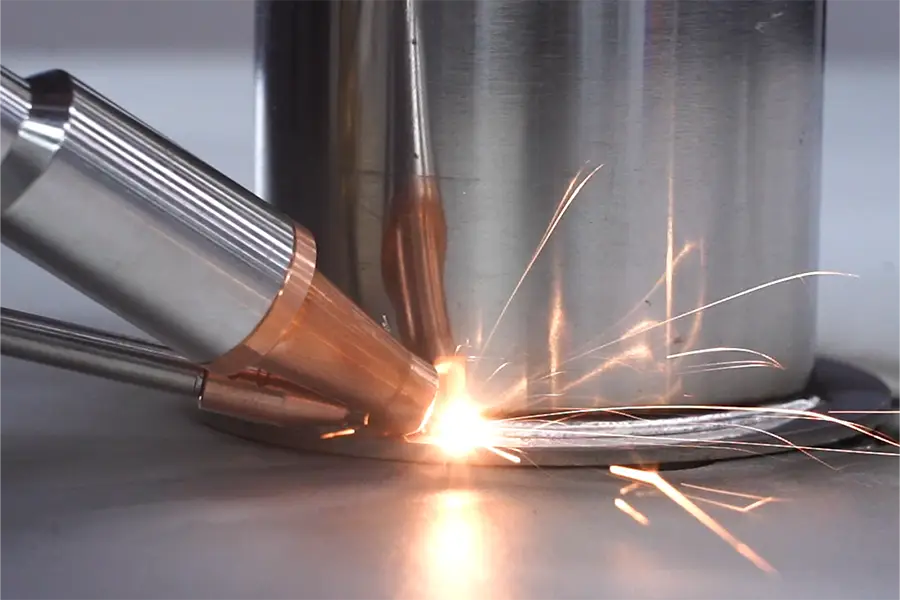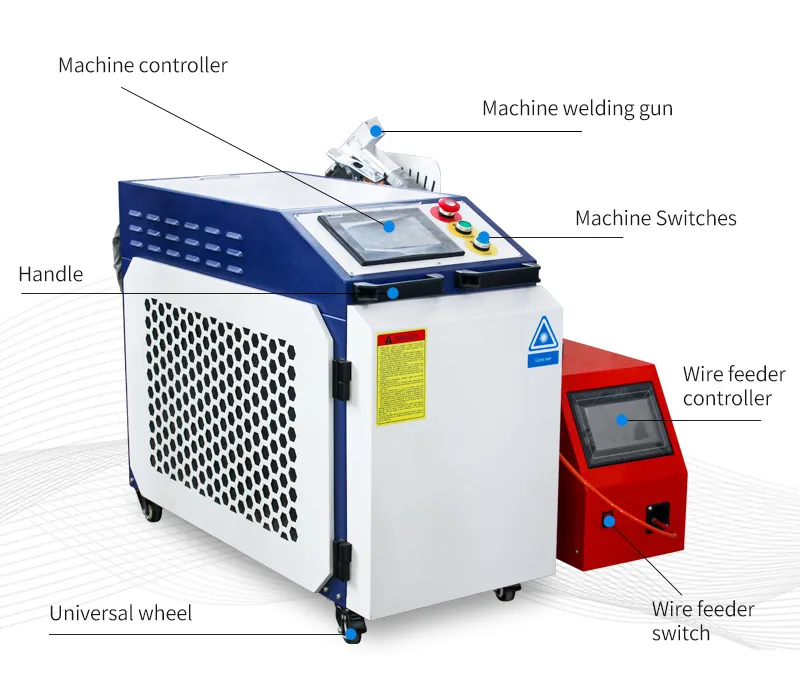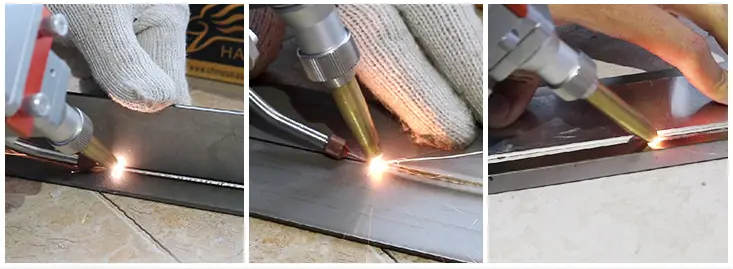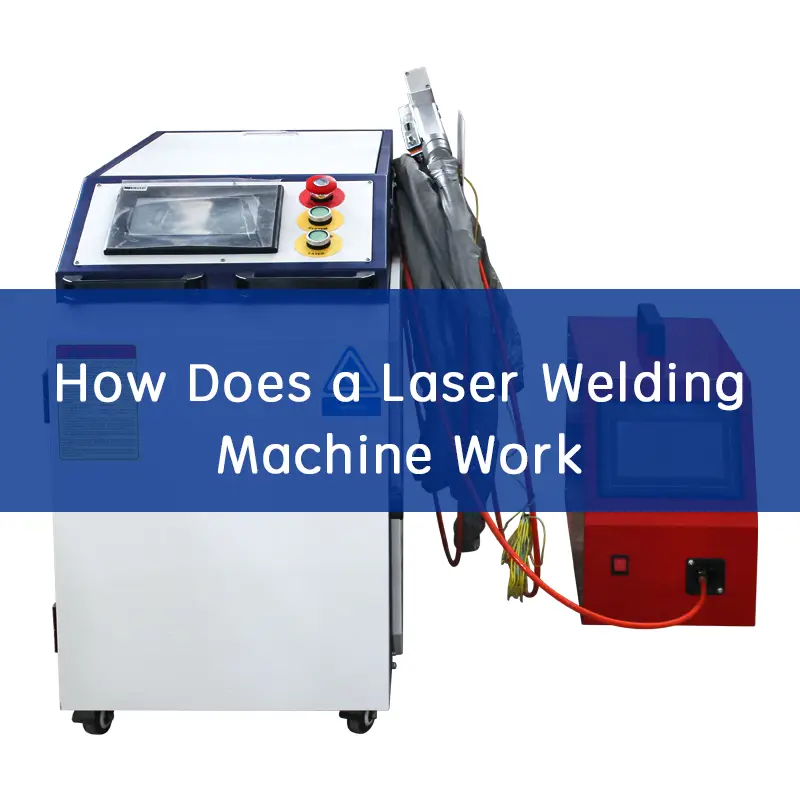Laser welding machines have revolutionized the manufacturing and repair industries by providing precise, efficient, and versatile welding solutions. In particular, portable handheld laser welding machines have become increasingly popular due to their mobility and ease of use.
This article delves into the workings of laser welding machines, their benefits, cost, and usage, ensuring that it answers all your questions about these innovative devices.
How Does a Laser Welding Machines Work?

At its core, a laser welding machine uses a focused beam of light to melt and fuse materials together. The laser generates a high-intensity beam that is directed onto the workpiece, creating a small but intensely hot area that melts the material. As the molten material cools, it solidifies, forming a strong weld. This process is precise and can be controlled to produce welds of varying sizes and depths.
How laser welding machine works can be broken down into several key steps:
- Generation of the Laser Beam: The laser welding machine contains a laser source, which could be a fiber laser, CO₂ laser, or another type of laser. This source generates the laser beam.
- Focusing the Beam: The generated beam is directed through a series of lenses and mirrors that focus it onto the workpiece. The focusing system ensures that the beam is concentrated on a small area, which increases its intensity and effectiveness.
- Movement of the Beam: In handheld models, the operator manually moves the welding head along the desired path. In automated systems, CNC (computer numerical control) mechanisms precisely control the beam’s movement.
- Melting and Fusing: As the focused laser beam hits the workpiece, it melts the material at the point of contact. The molten material from the two pieces to be joined mixes and then solidifies as the beam moves away, creating a strong weld.
The Mechanics of Portable Handheld Laser Welding Machines

Portable handheld laser welding machines combine the power and precision of laser welding with the flexibility of a mobile device. These machines typically consist of a laser source, a cooling system, a handheld welding head, and a control unit.
Key Components
- Laser Source: This is the heart of the machine, generating the laser beam. Fiber lasers are commonly used in portable models due to their efficiency and compact size.
- Handheld Welding Head: This part is designed to be lightweight and ergonomic, allowing the operator to maneuver it easily. It includes the focusing lenses and a protective nozzle.
- Cooling System: Laser welding generates significant heat, so a cooling system is necessary to prevent overheating. This can be an air or water cooling system, depending on the machine.
- Control Unit: The control unit allows the operator to adjust settings such as laser power, pulse duration, and beam focus. Advanced models may include touchscreens and programmable settings for different welding tasks.
Operation Process
To use a laser welding machine, the operator follows these steps:
- Setup: Position the workpieces to be welded securely. Ensure the machine is properly calibrated and settings are adjusted for the material type and thickness.
- Safety Precautions: Wear appropriate safety gear, including protective glasses and gloves. Ensure the workspace is free of flammable materials and that proper ventilation is in place.
- Welding: Hold the handheld welding head steady and direct the laser beam along the seam to be welded. Move the head at a consistent speed to ensure even heating and fusion.
- Cooling and Inspection: Allow the welded area to cool naturally or use additional cooling if necessary. Inspect the weld for quality and make any necessary adjustments or touch-ups.
Advantages of Using Laser Welding Machines
Laser welding machines offer several benefits over traditional welding methods:
- Precision: The focused laser beam allows for highly precise welds, which is particularly important for delicate or intricate parts.
- Speed: Laser welding is faster than many traditional methods, increasing productivity.
- Quality: The welds produced by laser machines are often stronger and cleaner, with minimal distortion or warping.
- Versatility: Laser welding can be used on a wide range of materials, including metals, plastics, and composites.
- Automation Potential: Laser welding can be easily automated, making it suitable for large-scale manufacturing processes.
How Much is a Laser Welding Machine?
The cost of a laser welding machine can vary widely depending on several factors, including the type of laser, power output, and additional features. High-end models with advanced features and higher power outputs can cost significantly more.
When considering the purchase of a laser welding machine, it’s important to factor in not only the initial cost but also the long-term savings in terms of efficiency, reduced material waste, and lower maintenance costs compared to traditional welding equipment.
How to Make a Laser Welding Machine?
How to make a laser welding machine is a complex question because it involves understanding advanced concepts in optics, electronics, and materials science. While building a laser welding machine from scratch is typically beyond the scope of most users, understanding the components and principles can help in customizing and maintaining the machine.
Working with a manufacturer or a specialist in laser technology is advisable for those interested in customization or building specific applications. They can provide insights into selecting the right laser source, designing an effective cooling system, and ensuring that all components are properly integrated for optimal performance.
How to Use Laser Welding Machine

How to use laser welding machine effectively involves a combination of proper setup, technique, and maintenance. Here are some practical tips to get the best results from your laser welding machine:
- Material Preparation: Clean the workpieces thoroughly to remove any contaminants that could affect the weld quality. Use proper fixtures to hold the pieces in place.
- Machine Calibration: Regularly calibrate your machine to ensure that the laser beam is accurately focused and that the power settings are appropriate for the material.
- Consistent Speed and Technique: Move the welding head at a consistent speed to ensure even heating and prevent defects. Practice different techniques to find the best approach for various materials and thicknesses.
- Maintenance: Keep the machine clean and well-maintained. Regularly inspect and replace worn components, such as lenses and nozzles, to ensure optimal performance.
- Safety: Always follow safety guidelines to protect yourself and others. Use proper protective equipment and ensure that the workspace is safe and compliant with regulations.
FAQs
Is laser welding as strong as MIG welding?
Laser welding can produce welds that are as strong as or stronger than MIG welding, depending on the materials and specific applications. Laser welding offers higher precision and can result in deeper penetration, leading to potentially stronger welds.
Are laser welders safe?
Yes, laser welders are safe when used correctly. Operators should always wear protective eyewear and follow safety guidelines to prevent exposure to harmful laser radiation and ensure a safe working environment.
How thick steel can a laser welder weld?
The thickness of steel a laser welder can weld depends on the power of the laser. Generally, portable handheld laser welders can weld steel up to 6-8 mm thick, but more powerful industrial models can handle thicker materials.
Is laser welding stronger than TIG?
Laser welding often produces stronger welds compared to TIG welding due to its precision and deeper penetration. However, the strength can vary based on the materials and specific applications.
How long do laser welders last?
Laser welders are built to last, with many machines having a lifespan of 50,000 to 100,000 hours of operation, depending on maintenance and usage conditions.
Conclusion
Understanding how does a laser welding machine work and mastering its use can significantly enhance your manufacturing or repair capabilities.
Portable handheld laser welding machines, in particular, offer a unique combination of precision, speed, and flexibility, making them an invaluable tool for a wide range of applications.
By following best practices in setup, operation, and maintenance, you can maximize the benefits of your laser welding machine and achieve high-quality results.
Whether you’re considering purchasing a machine, looking to understand its mechanics, or seeking practical tips for use, this guide provides the comprehensive information you need to make informed decisions and optimize your welding processes.

